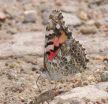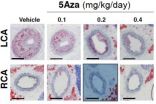(Press-News.org) CORVALLIS, Ore. – A new study of the colorful "eyespots" on the wings of some butterfly species is helping to address fundamental questions about evolution that are conceptually similar to the quandary Aristotle wrestled with about 330 B.C. – "which came first, the chicken or the egg?"
After consideration, Aristotle decided that both the egg and the chicken had always existed. That was not the right answer. The new Oregon State University research is providing a little more detail.
The study, published today in Proceedings of the Royal Society B, actually attempts to explain the existence of what scientists call "serial homologues," or patterns in nature that are repetitive, serve a function and are so important they are often retained through millions of years and across vast numbers of species.
Repeated vertebra that form a spinal column, rows of teeth, and groups of eyespots on butterfly wings are all examples of serial homologues. Researchers have tracked the similarities and changes of these serial features through much time and many species, but it's remained a question about how they originally evolved.
Put another way, it's easier to see how one breed of chicken evolved into a different breed of chicken, rather than where chickens – or their eggs - came from to begin with.
Butterfly wings are helping to answer that question. These eyespots, common to the butterfly family Nymphalidae, now serve many butterflies in dual roles of both predator avoidance and mate identification. One theory of their origin is that they evolved from simpler, single spots; another theory is that they evolved from a "band" of color which later separated into spots.
"What we basically conclude is that neither of the existing theories about butterfly eyespots is correct," said Jeffrey Oliver, a postdoctoral scholar in the Department of Integrative Biology of the OSU College of Science. "The evidence suggests that a few eyespots evolved as a group at about the same time, but behaved somewhat as individual entities."
Having appeared as a result of some genetic mutation, however, the eyespots then had the capability to move, acquire a function that had evolutionary value, and because of that value were retained by future generations of butterflies. And at all times, they retained the biological capacity for positional awareness – the eyespots formed in the same place until a new mutation came along.
"At first, it appears the eyespots helped this group of butterflies with one of the most basic aspects of survival value, which is avoiding predators," Oliver said.
On the side of the wing that predators saw when the wings were closed, the eyespots could have served as camouflage from a distance, and up close almost a "bulls-eye" for a predator to see and attack. But this directed the attack toward the tips of less-important wings, and not the more vulnerable head or body of the insect.
But just as important, Oliver said, the study indicates how through continued mutation these eyespots moved to a completely different place – the other side of the wing. There, they performed a completely different function – helping the butterfly to attract and be identified by optimal mates.
"If you take this same concept and apply it to other important features like vertebra and a spinal column, it suggests that some small number of bones would form through mutation, and eventually move, join and be perpetuated as they acquired a function with survival value," Oliver said.
"There would be a biological position in which they were supposed to form, and that would be retained," he said. "And over time, the vertebra might expand in number, and acquire other functions that had nothing to do with their original function, but which still had value."
The evolution of life has never been simple, as Aristotle and the other early philosophers found out. But one bone or butterfly eyespot at a time, the pieces continue to come together.
INFORMATION:
Editor's Note: Digital images of butterflies are available to illustrate this story.
Squinting bush brown, showing "eyespots": http://bit.ly/1jYtyKz
Painted lady: http://bit.ly/1hvwqJp
Butterfly 'eyespots' add detail to the story of evolution
2014-05-28
ELSE PRESS RELEASES FROM THIS DATE:
Should sugary drinks carry a health warning?
2014-05-28
In a personal view published on bmj.com today, a professor of public health at a leading university thinks there should be health warning labels on sugary drinks.
Professor Simon Capewell, professor at the University of Liverpool, highlights that the State of California is considering a new health bill. One which will see sugary drinks labelled with health warnings, vending machines to bear warning labels, and fines of between $50 and $500 per failed inspection".
Professor Capewell thinks this is a good idea, and one that the UK public would support.
He says that ...
Higher NHS spending in deprived areas can reduce health inequalities
2014-05-28
A policy of higher NHS spending in deprived areas compared with affluent areas is associated with a reduction in absolute health inequalities from causes amenable to healthcare in England, suggests a study published on bmj.com today.
In 1999, the government introduced a new 'health inequalities' objective for the allocation of NHS resources in England, which resulted in greater NHS spending in deprived areas with the worst health outcomes. But it is not known whether this policy was successful in contributing to a reduction in health inequalities.
So researchers based ...
School scheme unable to boost healthy eating and activity among kids
2014-05-28
A school-based scheme to encourage children to eat healthily and be active has had little effect, conclude researchers in a study published on bmj.com today.
The findings have relevance for researchers, policy makers, public health practitioners, and doctors, and they suggest that more intense interventions may be required.
Low levels of physical activity and of fruit and vegetable consumption in childhood are associated with adverse health outcomes. School based interventions have the potential to reach the vast majority of children, and evidence reviews have suggested ...
Barriers to HIV testing in older children
2014-05-28
Concerns about guardianship and privacy can discourage clinics from testing children for HIV, according to new research from Zimbabwe published this week in PLOS Medicine. The results of the study, by Rashida A. Ferrand of the London School of Hygiene & Tropical Medicine and colleagues, provide much-needed information on how to improve care of this vulnerable population.
More than three million children globally are living with HIV (90% in sub-Saharan Africa) and in 2011 an estimated 1000 infant infections occurred every day. HIV acquired through mother-to-child transmission ...
Making research findings freely available is an essential aid to medical progress
2014-05-28
In a PLOS Medicine guest editorial, Paul Glasziou, Professor of Evidence-Based Medicine at Bond University in Australia, explores how open access publications could help moderate and reduce the vast waste of global medical research.
Continuing on from his previous work, which highlighted how most of the world's expenditure on medical research was thrown away, Glasziou outlines how bad the situation is and suggests how it might be improved. Subscription-based academic journals make money by through copyrights assigned by authors to publishers who lock the articles behind ...
Dealing with stress -- to cope or to quit?
2014-05-28
Cold Spring Harbor, NY – We all deal with stress differently. For many of us, stress is a great motivator, spurring a renewed sense of vigor to solve life's problems. But for others, stress triggers depression. We become overwhelmed, paralyzed by hopelessness and defeat. Up to 20% of us will struggle with depression at some point in life, and researchers are actively working to understand how and why this debilitating mental disease develops.
Today, a team of researchers at Cold Spring Harbor Laboratory (CSHL) led by Associate Professor Bo Li reveals a major insight ...
Intertwined evolution of human brain and brawn
2014-05-28
The cognitive differences between humans and our closest living cousins, the chimpanzees, are staggeringly obvious. Although we share strong superficial physical similarities, we have been able to use our incredible mental abilities to construct civilisations and manipulate our environment to our will, allowing us to take over our planet and walk on the moon while the chimps grub around in a few remaining African forests.
But a new study suggests that human muscle may be just as unique. Scientists from Shanghai's CAS-MPG Partner Institute for Computational Biology, together ...
Disturbance in blood flow leads to epigenetic changes and atherosclerosis
2014-05-28
Disturbed patterns of blood flow induce lasting epigenetic changes to genes in the cells that line blood vessels, and those changes contribute to atherosclerosis, researchers have found. The findings suggest why the protective effects of good blood flow patterns, which aerobic exercise promotes, can persist over time. An epigenetic change to DNA is a chemical modification that alters whether nearby genes are likely to be turned on or off, but not the letter-by-letter sequence itself.
The results are scheduled for publication in the Journal of Clinical Investigation.
Atherosclerosis ...
Keeping active pays off even in your 70s and 80s
2014-05-28
Older people who undertake at least 25 minutes of moderate or vigorous exercise everyday need fewer prescriptions and are less likely to be admitted to hospital in an emergency, new research has revealed.
The findings, published in the journal PLOS ONE, reinforce the need for exercise programmes to help older people stay active. It could also reduce reliance on NHS services and potentially lead to cost savings.
In the first study of its kind looking at this age group, researchers from the University of Bristol looked at data from 213 people whose average age was 78.
Those ...
Endoscopic procedure does not reduce disability due to pain following gallbladder removal
2014-05-27
In certain patients with abdominal pain after gallbladder removal (cholecystectomy), undergoing an endoscopic procedure involving the bile and pancreatic ducts did not result in fewer days with disability due to pain, compared to a placebo treatment, according to a study in the May 28 issue of JAMA.
Post-cholecystectomy pain is a common clinical problem. More than 700,000 patients undergo cholecystectomy each year in the United States, and at least 10 percent are reported to have pain afterwards. Most of these patients have no significant abnormalities on imaging or ...



